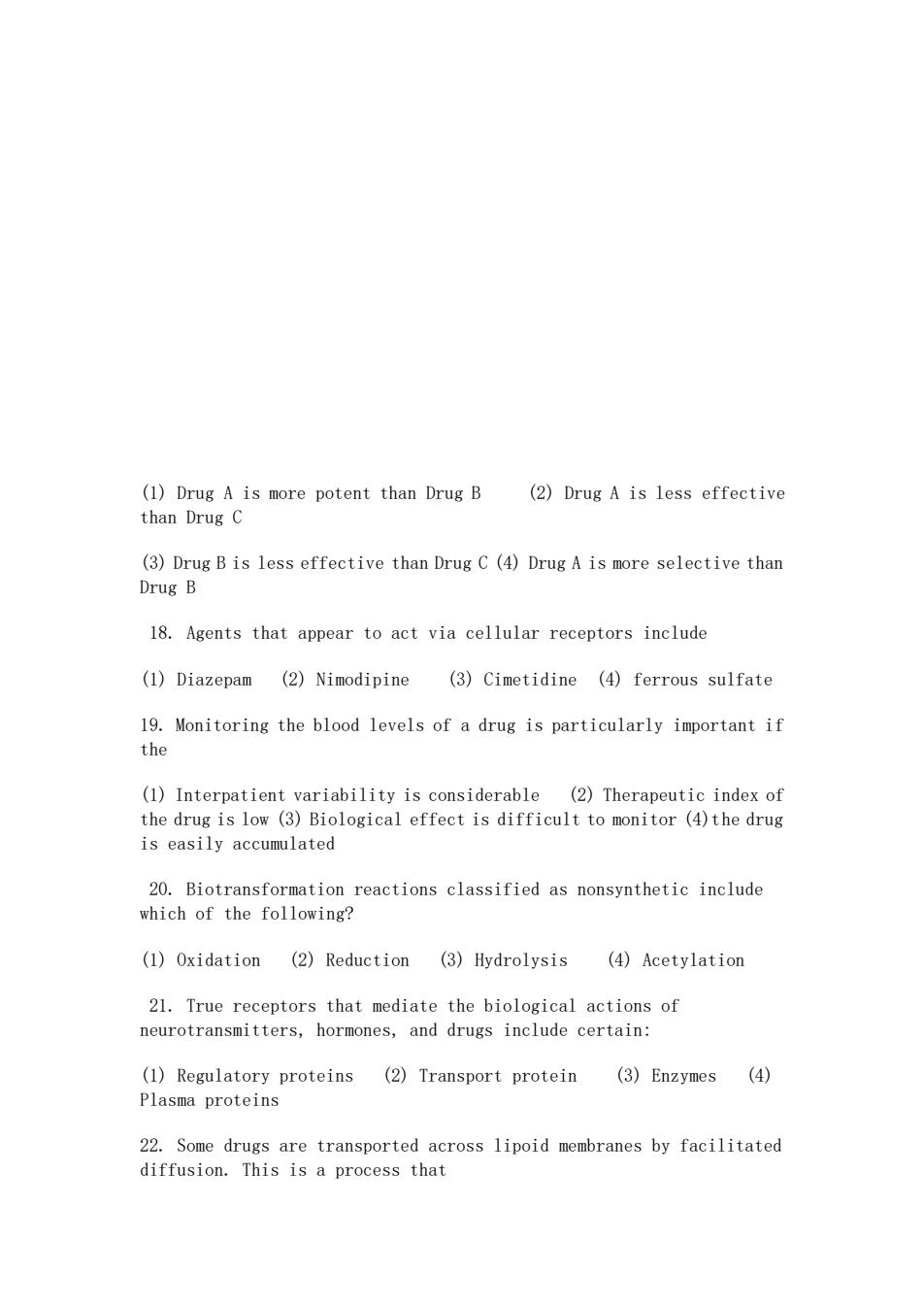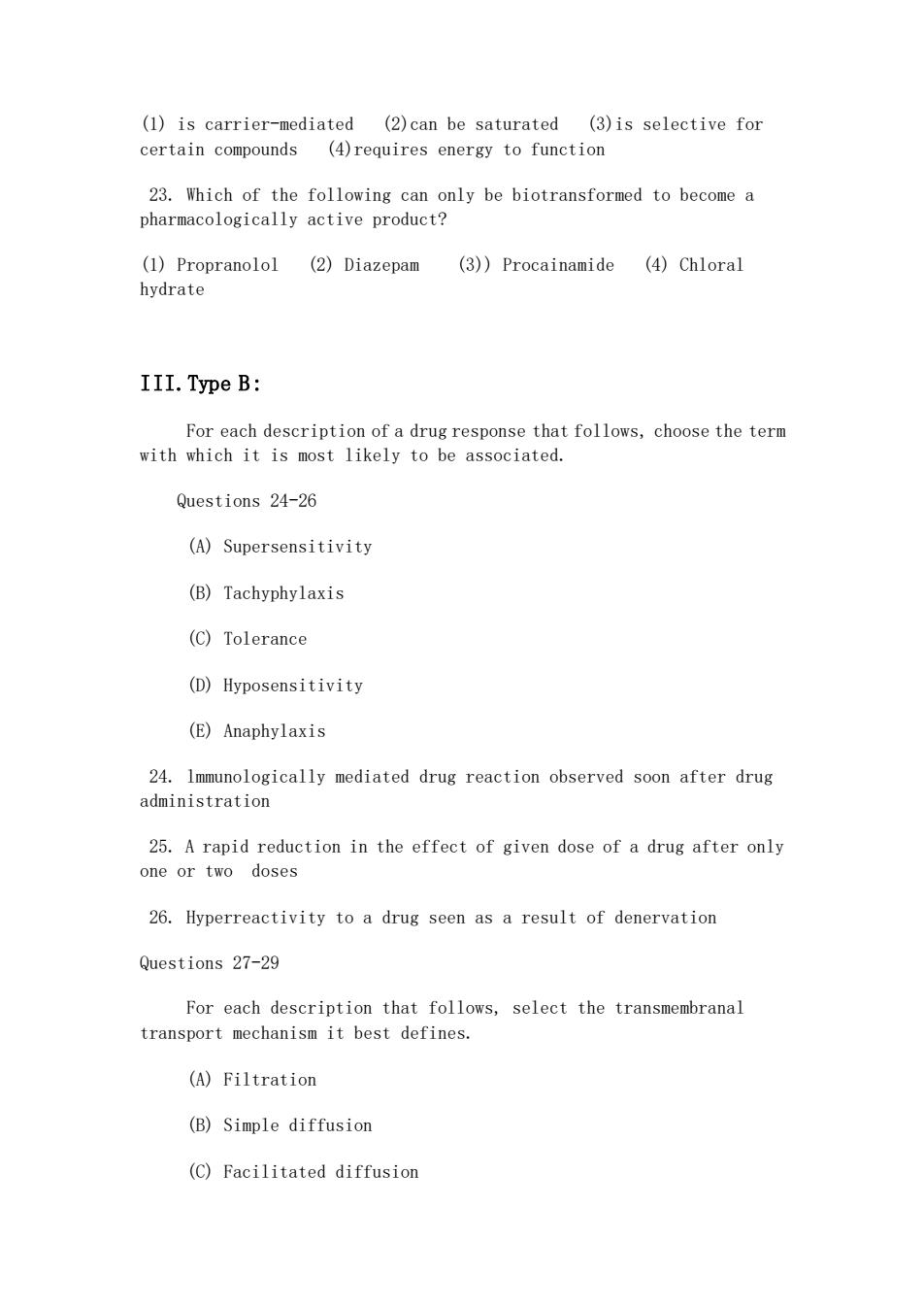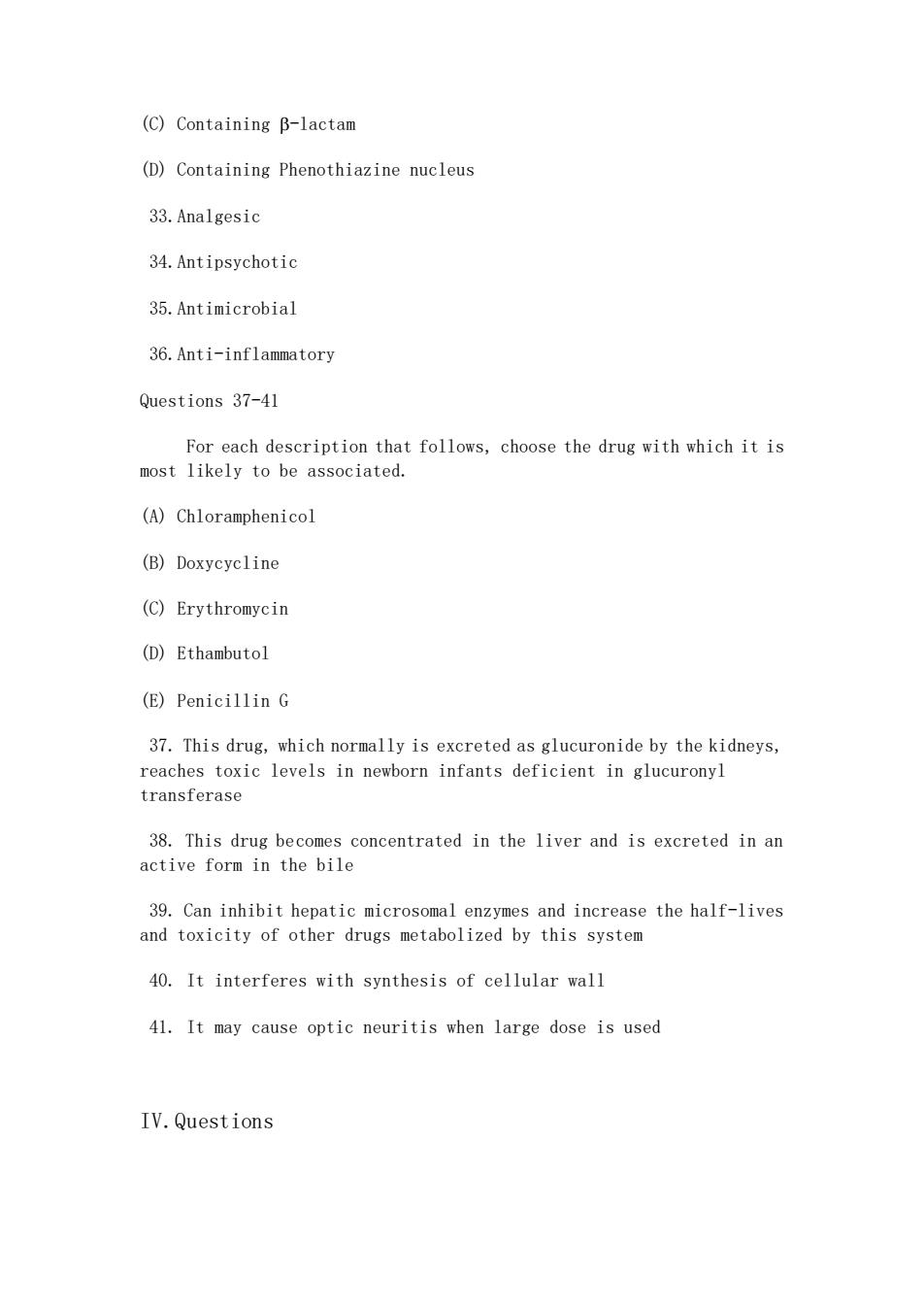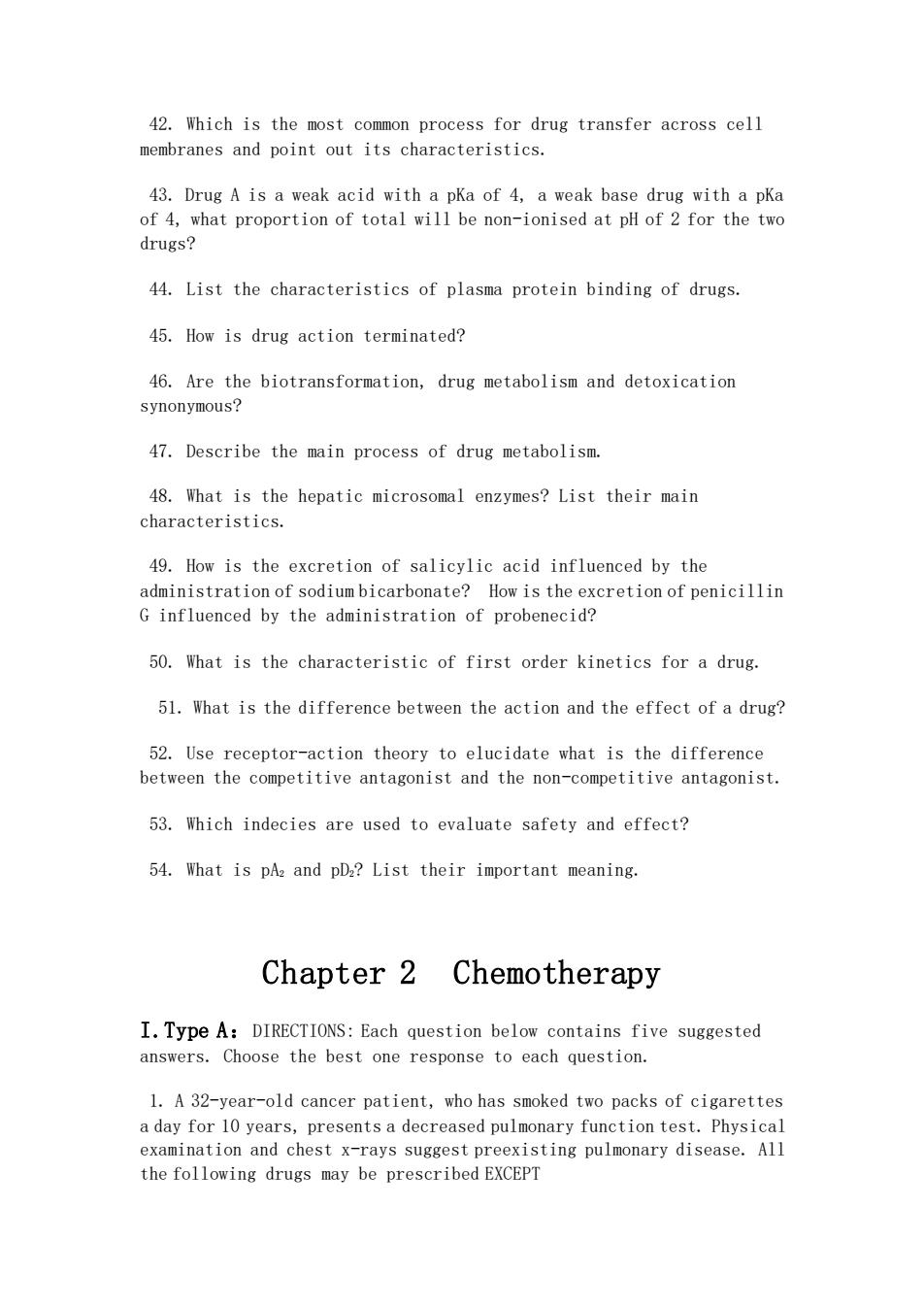
(1)Drug A is more potent than Drug B (2)Drug A is less effective than Drug C (3)Drug B is less effective than Drug C(4)Drug A is more selective than Drug B 18.Agents that appear to act via cellular receptors include (1)Diazepam (2)Nimodipine (3)Cimetidine (4)ferrous sulfate 19.Monitoring the blood levels of a drug is particularly important if the (1)Interpatient variability is considerable (2)Therapeutic index of the drug is low (3)Biological effect is difficult to monitor (4)the drug is easily accumulated 20.Biotransformation reactions classified as nonsynthetic include which of the following? (1)Oxidation (2)Reduction (3)Hydrolysis (4)Acetylation 21.True receptors that mediate the biological actions of neurotransmitters,hormones,and drugs include certain: (1)Regulatory proteins (2)Transport protein (3)Enzymes (4) Plasma proteins 22.Some drugs are transported across lipoid membranes by facilitated diffusion.This is a process that
(1) Drug A is more potent than Drug B (2) Drug A is less effective than Drug C (3) Drug B is less effective than Drug C (4) Drug A is more selective than Drug B 18. Agents that appear to act via cellular receptors include (1) Diazepam (2) Nimodipine (3) Cimetidine (4) ferrous sulfate 19. Monitoring the blood levels of a drug is particularly important if the (1) Interpatient variability is considerable (2) Therapeutic index of the drug is low (3) Biological effect is difficult to monitor (4)the drug is easily accumulated 20. Biotransformation reactions classified as nonsynthetic include which of the following? (1) Oxidation (2) Reduction (3) Hydrolysis (4) Acetylation 21. True receptors that mediate the biological actions of neurotransmitters, hormones, and drugs include certain: (1) Regulatory proteins (2) Transport protein (3) Enzymes (4) Plasma proteins 22. Some drugs are transported across lipoid membranes by facilitated diffusion. This is a process that

(1)is carrier-mediated (2)can be saturated (3)is selective for certain compounds (4)requires energy to function 23.Which of the following can only be biotransformed to become a pharmacologically active product? (1)Propranolol (2)Diazepam (3))Procainamide (4)Chloral hydrate III.Type B: For each description of a drug response that follows,choose the term with which it is most likely to be associated. Questions 24-26 (A)Supersensitivity (B)Tachyphylaxis (C)Tolerance (D)Hyposensitivity (E)Anaphylaxis 24.Immunologically mediated drug reaction observed soon after drug administration 25.A rapid reduction in the effect of given dose of a drug after only one or two doses 26.Hyperreactivity to a drug seen as a result of denervation Questions 27-29 For each description that follows,select the transmembranal transport mechanism it best defines. (A)Filtration (B)Simple diffusion (C)Facilitated diffusion
(1) is carrier-mediated (2)can be saturated (3)is selective for certain compounds (4)requires energy to function 23. Which of the following can only be biotransformed to become a pharmacologically active product? (1) Propranolol (2) Diazepam (3)) Procainamide (4) Chloral hydrate III.Type B: For each description of a drug response that follows, choose the term with which it is most likely to be associated. Questions 24-26 (A) Supersensitivity (B) Tachyphylaxis (C) Tolerance (D) Hyposensitivity (E) Anaphylaxis 24. lmmunologically mediated drug reaction observed soon after drug administration 25. A rapid reduction in the effect of given dose of a drug after only one or two doses 26. Hyperreactivity to a drug seen as a result of denervation Questions 27-29 For each description that follows, select the transmembranal transport mechanism it best defines. (A) Filtration (B) Simple diffusion (C) Facilitated diffusion

(D)Active transport (E)Endocytosis 27.Lipid-soluble drugs cross the membrane at a rate proportional to the concentration gradient across the membrane and the lipid:water partition coefficiency of the drug 28.Bulk flow of water through membrane pores,resulting from osmotic differences across the membrane,transports drug molecules that fit through the membrane pores 29.Cell membranes engulf droplets of solutions that are released inside the cell Questions 30-32 For each type of incompatibility described below,select the pair of substances that illustrates it. (A)Tetracycline and ferrous iron (B)Penicillin G and sreptomycin (C)Isoproterenol and propranolol (D)Hydralazine and reserpine (E)Doxycycline and trimethoprim 30.Therapeutic incompatibility 31.Physical incompatibility 32.Chemical incompatibility Questions 33-36 Many families of drugs consist of members that vary only with respect to substituents on a common ring structure.For each type of pharmacologic effect that follows,select the ring structure with which it is most likely to be associated. (A)Containing steroid nucleus (B)Containing pentacyclic opiate structure
(D) Active transport (E) Endocytosis 27. Lipid-soluble drugs cross the membrane at a rate proportional to the concentration gradient across the membrane and the lipid:water partition coefficiency of the drug 28. Bulk flow of water through membrane pores, resulting from osmotic differences across the membrane, transports drug molecules that fit through the membrane pores 29. Cell membranes engulf droplets of solutions that are released inside the cell Questions 30-32 For each type of incompatibility described below, select the pair of substances that illustrates it. (A) Tetracycline and ferrous iron (B) Penicillin G and sreptomycin (C) Isoproterenol and propranolol (D) Hydralazine and reserpine (E)Doxycycline and trimethoprim 30.Therapeutic incompatibility 31.Physical incompatibility 32.Chemical incompatibility Questions 33-36 Many families of drugs consist of members that vary only with respect to substituents on a common ring structure. For each type of pharmacologic effect that follows, select the ring structure with which it is most likely to be associated. (A) Containing steroid nucleus (B) Containing pentacyclic opiate structure

(C)Containing B-lactam (D)Containing Phenothiazine nucleus 33.Analgesic 34.Antipsychotic 35.Antimicrobial 36.Anti-inflammatory Questions 37-41 For each description that follows,choose the drug with which it is most likely to be associated. (A)Chloramphenicol (B)Doxycycline (C)Erythromycin (D)Ethambutol (E)Penicillin G 37.This drug,which normally is excreted as glucuronide by the kidneys, reaches toxic levels in or infants deficient in glucurony transferase 38.This drug becomes concentrated in the liver and is excreted in an active form in the bile 39.Can inhibit hepatic microsomal enzymes and increase the half-lives and toxicity of other drugs metabolized by this system 40.It interferes with synthesis of cellular wall 41.It may cause optic neuritis when large dose is used IV.Questions
(C) Containing -lactam (D) Containing Phenothiazine nucleus 33.Analgesic 34.Antipsychotic 35.Antimicrobial 36.Anti-inflammatory Questions 37-41 For each description that follows, choose the drug with which it is most likely to be associated. (A) Chloramphenicol (B) Doxycycline (C) Erythromycin (D) Ethambutol (E) Penicillin G 37. This drug, which normally is excreted as glucuronide by the kidneys, reaches toxic levels in newborn infants deficient in glucuronyl transferase 38. This drug becomes concentrated in the liver and is excreted in an active form in the bile 39. Can inhibit hepatic microsomal enzymes and increase the half-lives and toxicity of other drugs metabolized by this system 40. It interferes with synthesis of cellular wall 41. It may cause optic neuritis when large dose is used IV.Questions

42.Which is the most common process for drug transfer across cell membranes and point out its characteristics. 43.Drug A is a weak acid with a pKa of 4,a weak base drug with a pKa of 4,what proportion of total will be non-ionised at pH of 2 for the two drugs'? 44.List the characteristics of plasma protein binding of drugs. 45.How is drug action terminated? 46.Are the biotransformation,drug metabolism and detoxication synonymous? 47.Describe the main process of drug metabolism. 48.What is the hepatic microsomal enzymes?List their main characteristics. 49.How is the excretion of salicylic acid influenced by the administration of sodiumbicarbonate?How is the excretion of penicillin G influenced by the administration of probenecid? 50.What is the characteristic of first order kinetics for a drug. 51.What is the difference between the action and the effect of a drug? 52.Use receptor-action theory to elucidate what is the difference between the competitive antagonist and the non-competitive antagonist. 53.Which indecies are used to evaluate safety and effect? 54.What is pAe and pDa?List their important meaning. Chapter 2 Chemotherapy I.Type A:DIRECTIONS:Each question below contains five suggested answers.Choose the best one response to each question. 1 A 32-vear-old cancer patient.who has smoked two packs of cigarettes kamination and chest xrays suggest preexisting pulmonary disease.All the following drugs may be prescribed EXCEPT
42. Which is the most common process for drug transfer across cell membranes and point out its characteristics. 43. Drug A is a weak acid with a pKa of 4, a weak base drug with a pKa of 4, what proportion of total will be non-ionised at pH of 2 for the two drugs? 44. List the characteristics of plasma protein binding of drugs. 45. How is drug action terminated? 46. Are the biotransformation, drug metabolism and detoxication synonymous? 47. Describe the main process of drug metabolism. 48. What is the hepatic microsomal enzymes? List their main characteristics. 49. How is the excretion of salicylic acid influenced by the administration of sodium bicarbonate? How is the excretion of penicillin G influenced by the administration of probenecid? 50. What is the characteristic of first order kinetics for a drug. 51. What is the difference between the action and the effect of a drug? 52. Use receptor-action theory to elucidate what is the difference between the competitive antagonist and the non-competitive antagonist. 53. Which indecies are used to evaluate safety and effect? 54. What is pA2 and pD2? List their important meaning. Chapter 2 Chemotherapy I.Type A:DIRECTIONS: Each question below contains five suggested answers. Choose the best one response to each question. 1. A 32-year-old cancer patient, who has smoked two packs of cigarettes a day for 10 years, presents a decreased pulmonary function test. Physical examination and chest x-rays suggest preexisting pulmonary disease. All the following drugs may be prescribed EXCEPT